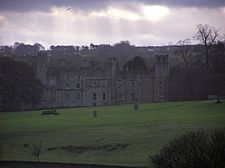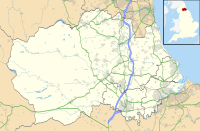Witton Castle facts for kids
Quick facts for kids Witton Castle |
|
|---|---|
| County Durham, England | |

Witton Castle
|
|
| Coordinates | 54°40′06″N 1°45′51″W / 54.6684°N 1.7643°W |
| Type | Rebuilt in 19th century |
Witton Castle is an old castle from the 1400s that has been changed a lot over time. Today, it's the main part of a holiday and caravan park in Witton le Wear, near Bishop Auckland, in County Durham. It is a Grade II* listed building, which means it's a very important historic building that needs to be protected.
Contents
The Castle's Early History
In 1410, a man named Sir Ralph Eure got special permission to build a castle on his land. This permission, called a "licence to crenellate," allowed him to add battlements and towers, making his manor house into a strong castle.
Witton Castle and the Civil War
During the English Civil War (a big conflict in England in the 1600s), Witton Castle was owned by Sir William Darcy. He was a Cavalier, which meant he supported King Charles I against the Parliament. After the war, his property was taken away. He had to pay a large fine to get his estate back. Later, in 1743, his family sold the castle to William Cuthbert.
Fires and New Owners
Not long after, the castle was bought by the Hopper family. But in 1796, a terrible fire broke out. It badly damaged Witton Castle, destroying most of the rooms inside.
In 1816, William Chaytor bought the castle and its land for £78,000. He was from Croft Hall in Yorkshire. Sir William worked hard to fix the castle's structure and rebuilt the inside in a more modern style for his time.
Coal and the Chaytor Family
The land around Witton Castle was rich in coal. In 1825, a coal mine called Witton Park Colliery was opened nearby. This brought a lot of money to the estate. Sir William Chaytor also held an important local position, serving as High Sheriff of Durham in 1839. The Chaytor family continued to live at Witton Castle for many years, right up until the middle of the 1900s.


